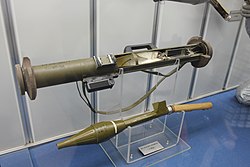Top Qs
Timeline
Chat
Perspective
PF-89
Anti-tank, anti-bunker rocket launcher From Wikipedia, the free encyclopedia
Remove ads
The PF-89 or Type 89 is a portable, disposable, unguided, shoulder-launched, anti-tank rocket-propelled rocket launcher. Developed by Norinco for the People's Liberation Army (PLA), the PF-89 was designed to replace the obsolete Type 69 RPG, providing a man-portable, single-use assault weapon system that could be used mainly by infantry squads to engage and defeat light armour and bunkers.[1]
Its design permits accurate delivery of a rocket-propelled 80mm high-explosive anti-tank (HEAT) warhead, with negligible recoil. The PF-89 entered mass production in 1993, and generally replaced the Type 69 RPG in the PLA throughout the 1990s.[1] Since 2010, the system has been used along with the more advanced Type 08 recoilless gun.[2]
Remove ads
Description
Summarize
Perspective
The PF-89 is a lightweight, self-contained, anti-armour weapon comparable to the Swedish AT4 (U.S. Designation M136). However, unlike the AT4, the PF-89 is a rocket-propelled weapon instead of a recoilless gun, making the PF-89 more similar to the M72 LAW and the RPG-26. The weapon consists of a free-flight, fin-stabilized, rocket-propelled cartridge packed in a one-piece, one-off, fiberglass-wrapped tube.[3]
It is man-portable and is fired from the right shoulder only. The launcher is watertight for ease of transportation and storage. The PF-89 has a simple 2.5x, 12° field of view optical sight for aiming, with no night combat ability.[4]
The user must be able to see and identify the target and estimate the range to it. The round of ammunition is self-contained in a disposable launch tube. The system weighs only eight pounds and can be used effectively with minimal training.[1]
The problem of back blast became prominent after the PF-89's adoption. Collateral damage is especially concerning for the PLA, which uses motorized infantry fighting tactics. To address this, China developed the Type 08 multipurpose recoilless gun with a countermass balance mechanism to replace the PF-89, especially the multipurpose PF89A variant.[2]
Remove ads
Development
The development of the PF-89 was initiated in 1984, and the rocket launcher was certified in 1989, receiving the designation PF-89. By 1993, the launcher entered serial production and large-scale active service within the PLA. Between 1991 and 1993, China developed the PF-89A, a multipurpose incendiary round designed to engage structures, personnel, and light vehicles. PF-89A has a new telescopic sight attached that features a reticle range up to 1000 meters. Between 1994 and 1998, China developed a tandem HEAT version of the rocket for engagement against targets with reactive armour, which received the designation PF-89B.[5]
In 2002, China certified WPF-89-1, a variant with a thermobaric warhead. WPF-89-1 variant has a reusable launcher, which is cumbersome to reload. In the same year, China developed a single-use version called WPF-89-2, with an additional tandem-charged warhead for better thermobaric performance.[6]
Remove ads
Variants
Summarize
Perspective
The PF-89 has six variants, with each variant corresponding to a specific type of ammunition. The earliest variant, simply called the PF-89, uses high-explosive double shaped charges (with 8701 explosives) to achieve 628mm of rolled homogeneous armour (RHA) penetration at 90° angle in static tests. In kinetic tests, the RHA penetration is more than 400mm at 0° angle or 180mm at 68° angle.[4][5]
The second variant, the PF-89A, employs specialized multipurpose incendiary rounds. These multipurpose rounds can penetrate 300mm of reinforced concrete, and release steel fragments and zirconium-based incendiary composition to kill targets and light up wood and fabric upon impact.[1][4]
The third variant, known as the PF-89B or PF-89-1, uses tandem-charge HEAT warheads to improve penetration against reactive armour.[3][5]
The WPF-89-1 is the thermobaric version of the PF-89. The WPF-89-1 is reusable, but it did not see much use due to its complex reload process. China developed WPF-89-2, a single-use self-contained version, to replace WPF-89-1. The fuel air explosion (a type of thermobaric reaction) is most effective within confined space, thus, the WPF-89-2 warhead features a tandem charge function, allowing the warhead to penetrate the structure wall or light armour first, then trigger the fuel air explosion within the target space.[6]
A training replica version is also available for operational practice.[3]
Remove ads
Users
 Cambodia: Used by the Royal Cambodian Army.[7]
Cambodia: Used by the Royal Cambodian Army.[7] China: Used by the People's Liberation Army.
China: Used by the People's Liberation Army.
Non-state actors
 Libya: WPF-89-2s used by Fajr Libya.[8]
Libya: WPF-89-2s used by Fajr Libya.[8]
See also
References
External links
Wikiwand - on
Seamless Wikipedia browsing. On steroids.
Remove ads

